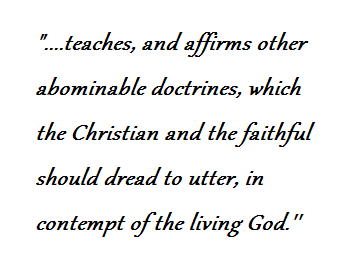The Summons
When Hamilton returned to Scotland in 1527 he began to preach his protestant beliefs in Linlithgowshire. Archbishop Beaton summoned him to appear before him and other senior clergy in St Andrews Cathedral. A copy of a summons connected with the case survives, stating that Hamilton:
“strives with all his  power and seeks to seduce from our true and orthodox faith and from the Church Catholic and to pervert them, saying, preaching, and daring to affirm in all publicity, among other things, that no obedience is due to laws, canons, ordinances of the Fathers and decrees, or any regulations of men: that the keys and censures of the Church are of no account, nor should trust be reposed in its sacraments; that people should not go to the Churches or worship images; that prayers should not be offered for the souls of the dead, or tithes paid to God and the Church; that for good works there will be no reward of salvation or torment for evil; that our ancestors in the Church of God and those who put their trust in its sacraments died in an evil and imperfect faith and are buried in hell, and preaches, teaches, and affirms other abominable doctrines, which the Christian and the faithful should dread to utter, in contempt of the living God, the keys of the Church, and our orthodox faith, to the damage and scandal of the common weal of Scotland, to her downfall by the merited vengeance of God.”
power and seeks to seduce from our true and orthodox faith and from the Church Catholic and to pervert them, saying, preaching, and daring to affirm in all publicity, among other things, that no obedience is due to laws, canons, ordinances of the Fathers and decrees, or any regulations of men: that the keys and censures of the Church are of no account, nor should trust be reposed in its sacraments; that people should not go to the Churches or worship images; that prayers should not be offered for the souls of the dead, or tithes paid to God and the Church; that for good works there will be no reward of salvation or torment for evil; that our ancestors in the Church of God and those who put their trust in its sacraments died in an evil and imperfect faith and are buried in hell, and preaches, teaches, and affirms other abominable doctrines, which the Christian and the faithful should dread to utter, in contempt of the living God, the keys of the Church, and our orthodox faith, to the damage and scandal of the common weal of Scotland, to her downfall by the merited vengeance of God.”
The text of the summons of Patrick Hamilton for investigation for heresy was preserved because John Lauder (who was secretary to Cardinal Beaton and one of the prosecutors in the later trial of George Wishart) copied it into his formula book. The manuscript of Lauder’s formula book is held in the St Andrews University Library’s Special Collections (where it has traditionally been known as the St Andrews Formulare).
